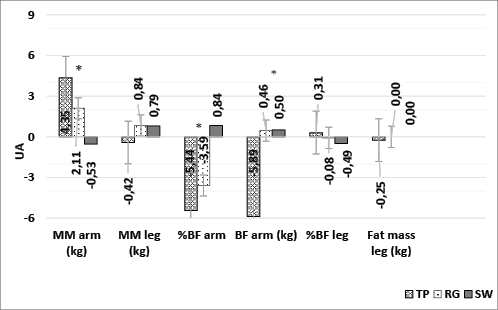
Available online at: https://doi.org/10.18778/1898-6773.87.1.01
 https://orcid.org/0000-0002-6941-7133
https://orcid.org/0000-0002-6941-7133
Department of Anatomy and Biomechanics, National Sports Academy “Vassil Levski”, Sofia, Bulgaria
Department of Anthropology and Anatomy, Institute of Experimental Morphology, Pathology and Anthropology with Museum, Bulgarian Academy of Sciences Sofia, Bulgaria
ABSTRACT: Assessing bilateral differences in paired anthropometric features is an important methodological problem in sports anthropology. The present study included 128 adolescent female athletes (59 rhythmic gymnasts, 58 tennis players, and 11 swimmers). Body composition components were determined using multi-frequency bioelectrical impedance measurements (analyzer InBody 170). Asymmetry coefficients of muscle and fat mass accumulation in the upper (AA) and lower (AL) limbs were calculated using the Nacheva` equation (1986). The percentiles method was applied to distribute the bilaterally studied anthropometric features according to the mean values of the units of asymmetry (UA). Wilkoxon-test was used to assess the statistically significant differences in paired variables. Kruskal-Wallis test was applied to determine the differences in UA between three assessed athlete groups, depending on their age. The differences in body composition components between rhythmic gymnasts (RG), tennis players (TP), and swimmers (SW) were well expressed in all assessed age groups. The most considerable inter-group differences were observed in terms of the asymmetry coefficient in the lean body mass (LBM) with a right direction and body fat mass with a left direction for upper limb fat mass (%, kg), which have signed the highest values in the tennis players group, followed by the RG on the same age. Swimmers had significantly the lowest values of UA for all body segments. A close relation was found between asymmetry in body composition variables and the type of sports activity. Tennis was found as a sport with more pronounced inter-limbs asymmetry.
KEY WORDS: tennis players, rhythmic gymnasts, swimmers, asymmetry, body composition.
The assessment of bilateral differences in paired anthropometric features is an important methodological problem in anthropology. Bilateral asymmetry in human beings arose millions of years ago in the process of the evolution as an adaptive mechanism to the changing environmental factors (Zeidel et al. 2010). Anthropometric asymmetry provides information about changes occurring in the morphofunctional characteristics of the human body, according to the type and intensity of physical activity (labor, sports, etc). Assessing bilateral differences in paired anthropometric features is of great interest worldwide in biomedical sciences. Asymmetric changes, mainly in the limbs, have been observed in athletes competing in a variety of sports: volleyball, handball, javelin throwing, cricket, racket sports, rhythmic gymnastics, football, etc (Koley 2008, 2010; Stoykov 2012; Rynkiewicz 2013; Schluga-Filho et. al. 2016; etc.).
To achieve higher productivity in rhythmic gymnastics, gymnasts often perform repetitive motor actions, mainly with the dominant limb (Teixeira and Paroli 2000; Zaidi 2011). This leads to greater values of the thigh circumference and a greater angle of extension in the knee and hip joint compared to the contra-lateral limb (Georgopoulos et al. 1999; Douda et al. 2002; Frutuoso et al. 2016).
Tennis, similarly to rhythmic gymnastics, is a sport with an asymmetric etiology, especially existing in the upper limbs. The asymmetric accumulation of fat mass and lean mass between the right and left arms give rise to disproportions in the bones (Vergauwen 1998; Sánchez-Muñoz et al. 2007; Rogowski 2008, 2016; Abrahão et al. 2008; Berdejo-del-Fresno 2010). On the other hand, swimming is a sport that involves all muscles and provides a balanced body composition. Assessment of the effects of swimming training on body asymmetry in adolescents shows that continuous and intensive swimming during the growth periods does not cause body asymmetry in swimmers (Palomino-Martin et al. 2015).
Different studies associated the inter-limb asymmetries, of the lower-body greater than 10–15% with increased incidences of injury (Tyler et al. 2001; Bishop et al. 2018; Dos’Santos et al. 2019). The importance of the current research is to develop an accurate scale for assessing the directions and degree of the manifested morphological asymmetry, with aimed at preventing the health status of the athletes. In this reason:
The aim of the study is to evaluate the bilateral differences in body composition variables of adolescent athletes doing symmetric and asymmetric sports.
The present study included 128 adolescent female athletes (59 rhythmic gymnasts, 58 tennis players and 11 swimmers). All athletes identified themselves as right-handed. Study participants were divided into three experimental groups according to the age classification in sports practice as follows: age group 1 includes all rhythmic gymnasts (RG) tennis players (TP) and swimmers (SW) from 8 to 10 years, the age group 2: 11–12 years and the age group 3: 12–14-year-old athletes. The criteria for inclusion were as follows: all athletes trained at least 5 times per week and competed regularly at the regional, national or international level championships. Their training experience in current sport was as follows: the mean training experience equaled 5.21 ± 1.2 years in TP, 4.92 ± 1.3 years in RG and 5.30 ± 1.3 years in SW. The girls and their parents completed informed consent and voluntarily participated in the study. The study protocol was reviewed and approved by the Ethical Committee of Institute of Experimental Morphology, Pathology and Anthropology with Museum-Bulgarian Academy of Sciences (Protocol № 22/07.02.2023) and was conducted in agreement with the principles stated in the Declaration of Helsinki for human studies (WHO 2008). Body mass index was calculated by a well-known formula using the mean height and weight values. Body composition components were determined by means of multi-frequency bioelectrical impedance measurements, which were taken with the use of InBody (model: 170) analyzer, with eight electrodes. For accurate analysis, the following requirements have been met: the measurements of each athlete were made at least two hours after a meal and at least 12 hours before training. Statistical analysis was conducted using the SPSS software, version16.00, for Windows. Verification of the normal distribution of the anthropometric and body composition measurements and a non-normal distribution of one of the asymmetric coefficients prompted the use of the Kolmogorov-Smirnov and Shapiro-Wilk tests. Asymmetry coefficients of muscle mass and fat mass accumulationin the upper (UL) and lower (LL) limbs were calculated using the Nacheva` equation (1986):
Units of asymmetry (UA) = (dominant limb / dominant limb · 100) – 100
The percentiles` method was applied to distribute the bilaterally studied anthropometric features according to the mean values of the units of asymmetry (UA). Wilkoxon-test was applied to assess the statistical significant differences in paired variables (p ≤ 0.05). Kruskal-Wallis test (p ≤ 0.05) was applied to assess the differences in UA between three assessed athlete` groups, depending to their age.
All RG (mean age: 11.19±1.74 y; mean body height: 146.30±9.17 cm; mean body weight: 34.24±6.61 kg) had training in gymnastics six days per week, not less than 20 hours weekly. All TP (mean age: 11.24±1.72 y; mean body height: 153.60±9.43 cm; mean body weight: 45.13±1.02 kg) had training in tennis more than three times weekly and not less than 10 hours per week. The swimmers’ training experience (mean age: 10.55±1.57 y; mean body height: 147.42±1.28 cm; mean body weight: 34.98±7.99 cm) was about five times per week and 90 minutes per training. Using results for height and weight, the mean values of BMI were observed. In TP it varied from 17.76 to 21.39 kg/cm2 at the ages between 8 and 14. The results obtained for the other athletes’ groups` were in the diapason from 15.31 to 16.90 kg/cm2 and from 15.45 to 16.39 kg/cm2 in RG and SW, respectively. TP exhibited the highest values of BMI compared to the RG and SW in all assessed age groups (p<001). During the assessed age period all athletes increased their BMI, most pronounced in the time between 11 and 14 years, due to the onset of puberty.
Bilateral differences in lean body mass and fat mass of the upper and lower limbs were presented in Fig. 1 (A, B, C). The largest differences between groups were observed for units of asymmetry, with a right direction for lean mass and a left direction for upper limb fat mass. Units of asymmetry had significantly highest values in the tennis player group, followed by the RG` group (p<0.001). Swimming appears to be the sport with much lower levels of bilateral limb soft tissue differences.

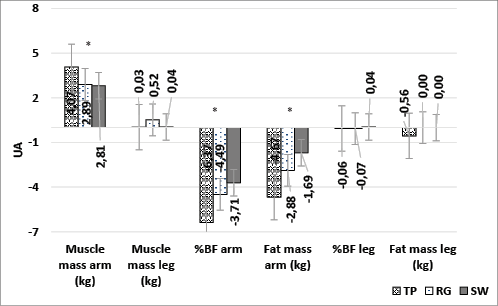
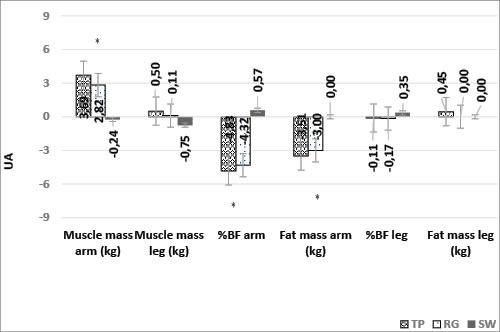
Fig. 1. Bilateral differences in lean body mass and fat mass in adolescent female athletes aged 8–10 years (1A), 11–12 years (1B), and 13–14 years (1C)
Based on the data on the percentile values of the UA, the profile of the anthropometric asymmetry of the athletes was established (Fig. 2A–Fig. 2C).

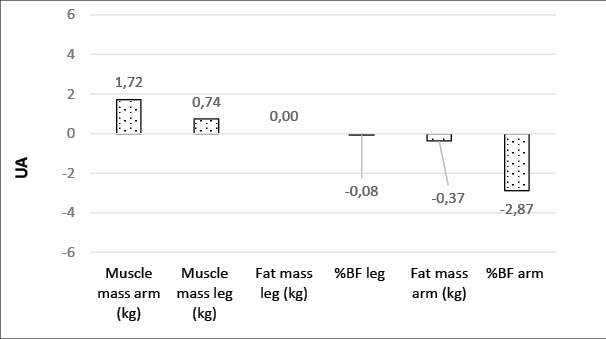
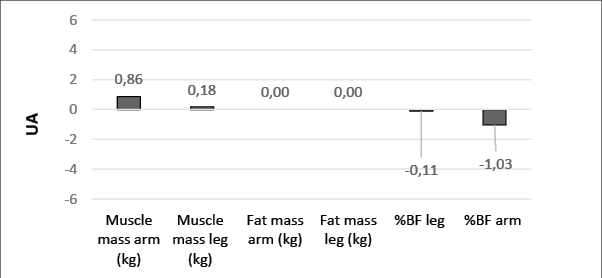
Fig. 2. Profile of the anthropometric asymmetry in: 8–14-years-old tennis players (2A), 8–14-years-old rhythmic gymnasts (2B), 8–14-years-old swimmers (2C)
The differences in body composition components between RG and TP were well expressed in the three age groups (p<0.001). Through all assessed age periods, TP had higher levels of asymmetry in muscle mass and fat mass of the upper limbs compared to the RG on the same age (p<0.001). Swimmers had significantly the lowest values of UA for all body segments (p<0.001).
The study presented the bilateral differences in sport-specific morphological peculiarities in youth female competitors doing different sports. Some researchers declared that the asymmetry is more pronounced in the upper extremities in comparison to lower extremities with the right side prevalence (Tomkinson et al. 2003; Malina and Buschang 2004; Ulijaszek and Mascie-Taylor 2005). Schell et al. (1985) marked that morphological asymmetry is one of the main problems of anthropology and a suitable methodology is needed to analyze this phenomenon. Anthropometry is the most traditional method to assess the differences in paired parts of the body. The segmental bio-electrical impedance analysis (BIA) is a newer method to investigate regional diversification of the lean and fat mass of the body compartments. A comparative study of body composition (BC) in Slovak young women and men, with the use of BIA, showed significantly higher values of active body components in men. Opposite to that a significantly higher values of non-active body components were detected in woman. The authors reported a positive correlation between BC and indices (Falbová et al. 2022). A significant association of smoking with the body composition components was found, while it was responsible for higher adiposity in young adults. Higher values of all anthropometric parameters and indexes in smoking young adults compared to non-smokers were recorded, with statistically significant differences in waist circumference, BMI, waist to hip ratio, and fat mass indexes (Falbová et al. 2023). The segmental analysis of body composition, through the applied bioimpedance method, gave the opportunity to make a more detailed study about the manifestations of morphological asymmetry in the muscle and fat mass of the limbs in adolescent athletes.
The active physical load of certain muscle groups of the dominant upper limb in tennis players leads to a decrease in the %BF and better developed of muscle mass. Throughout the studied age period, upper limbs muscle mass and upper limbs fat mass (%) showed a strong to very strong level of asymmetry in tennis players and a moderate level in rhythmic gymnasts. The direction of the manifested asymmetry for muscle and fat mass is right-sided and left-sided, respectively. The lower limbs were characterized by relative symmetry in terms of the distribution of soft tissues in the studied sports activities. Kistrop et al. (Kistrop et al. 2000) found that measuring whole body and regional body composition by DEXA can improve the prediction of energy expenditure what could be helpful information about athletes who try to lose fat mass or gain lean muscle. Abrahao et al. (2008) made comparison of the young athletes playing tennis for up to two years (age 6–10 years) with the male instructors between 22 y and 37 years of age that have been engaged in playing tennis at least eight years. The authors reported the increase of the incidence of right somatic measures superior to the left, because the excessive time of training of asymmetric sport, which, according to the researchers, influenced postural deviation (Abrahao et al. 2008).
This study found a strong relationship between asymmetry in body composition variables and the type of sports activity. Tennis was found as a sport with more pronounced inter-limbs asymmetry. Established by us a body asymmetry profile allows summarizing and systematizing the information about the dimensions and direction of the manifested bilateral differences.
Conflict of interests
No potential conflicts of interests were reported by the author.
Ethical Approval
Ethical approval was given by the Ethics Committee of the Institute of Experimental Morphology, Pathology, and Anthropology with Museum–Bulgarian Academy of Sciences (Protocol № 22/07.02.2023) and was conducted in agreement with the principles stated in the Declaration of Helsinki for human studies (2008).
Authors’ contribution
AD designed the study, collected the data, oversaw the statistical analysis/interpretation and agree to be accontable for all aspect of the work.
Abrahão MRA, Mello D. 2008. Diferenças antropométricas entre o hemi-corpo direito e o esquerdo de adultos instrutores de tênis e crianças iniciantes no esporte e 260 incidência de desvios posturais. Fitness & Performance Journal 7(4):264–270. https://doi.org/10.3900/fpj.7.4.264.p
Berdejo-del-Fresno D, Vicente-Rodriguez G, González-Ravé JM, Moreno LA, Rey-López JP. 2010. Body Composition and Fitness in Elite Spanish Children Tennis Players. JHSE V(II):250–264. https://doi.org/10.4100/jhse
Bishop C, Turner A, Read P. 2018. Effects of inter-limb asymmetries on physical and sports performance: A systematic review. J Sports Sci 36(10):1135–1144. https://doi.org/10.1080/02640414.2017.1361894
Dos’Santos T, Bishop C, Thomas C, Comfort P, Jones PA. 2019. The effect of limb dominance on change of direction biomechanics: A systematic review of its importance for injury risk. Phys Ther Sport 37:179–189. https://doi.org/10.1016/j.ptsp.2019.04.005
Douda HT, Toubekis AG, Avloniti AA, Tokmakidis SP. 2008. Physiological and anthropometric determinants of rhythmic gymnastics performance. Int J Sports Physiol Perform 3(1):41–54. https://doi.org/10.1123/ijspp.3.1.41
Falbová D, Vorobeľová l, Beňuš R. 2022. Gender-specific anthropometric and body composition analysis in slovak young adults. Anthropologie (Brno) 60(2):319–328. https://doi.org/10.26720/anthro.22.03.21.2
Falbová D, Beňuš R, Vorobeľová L. 2023. Association between smoking status and body composition parameters in a young adult population. Anthropol Rev 86(2):77–87. https://doi.org/10.18778/1898-6773.86.2.07
Frutuoso A, Diefenthaeler F, Vaz M, Freitas C. 2016. Lower limb asymmetries in Rhythmic Gymnastics athletes. IJSPT 11(1):34–43.
Georgopoulos N, Theodoropoulou A, Roupas N, Rottstein L, Tsekouras A, Mylonas P, Vagenakis GA, Koukkou E, Armeni AK, Sakellaropoulos G, Leglise M, Vagenakis AG, Markou K. 2012. Growth velocity and final height in elite female rhythmic and artistic gymnasts. Hormones 11(1):61–69. https://doi.org/10.1007/BF03401538
Koley S, Singh J, Sandhu SJ. 2010. Anthropometric and physiological characteristics on Indian inter-university volleyball players. J Hum Sport Exerc 5(3):389–399. https://doi.org/10.4100/jhse.2010.53.09
Koley S, Yadav M, Sandhu J. 2008. Estimation of Hand Grip Strength and its Association with some Anthropometric traits in Cricketers of Armitsar, Punjab, India. The Internet Journal of Biological Anthropology 3 (1).
Malina RM, Peña Reyes ME, Tan SK, Buschang PH, Little BB, Koziel S. 2004. Secular change in height, sitting height and leg length in rural Oaxaca, southern Mexico: 1968–2000. Ann Hum Biol 31(6):615–33. https://doi.org/10.1080/03014460400018077
Palomino-Martin A, Gonzalez-Martel V, Quiroga ME, Ortega-Santana F. 2015. Effects of Swimming Training on Body Asymmetry in Adolescents. Int J Morphol 33(2):507–513.
Rogowski I, Creveaux T, Genevois C, Klouche S, Rahme M, Hady P. 2016. Upper limb joint muscle/tendon injury and anthropometric adaptations in French competitive tennis players. Eur J Sport Sci 16(4):483–489. https://doi.org/10.1080/17461391.2015.1031712
Rogowski I, Ducher G, Brosseau O, Hautier C. 2008. Asymmetry in volume between dominant and nondominant upper limbs in young tennis players. Pediatr Exerc Sci 20:263–272. https://doi.org/10.1123/pes.20.3.263
Rynkiewicz M, Rynkiewicz T, Żurek P, Ziemann E, Szymanik R. 2013. Asymmetry of muscle mass distribution in tennis players. TSS 1(20):47–53.
Sánchez-Muñoz C, Sanz D, Zabala M. 2007. Anthropometric characteristics, body composition and somatotype of elite junior tennis players. Br J Sports Med 41:793–799. http://doi.org/10.1136/bjsm.2007.037119
Schluga-Filho JL, Ribas MR, Nogueira LO, Andrade JC, Fernandes P, Bassan JC. 2016. Motor and morphological profile of tennis players from 11 to 15 years old. Rev Andal Med 9(3). https://doi.org/114–118. 10.1016/j.ramd.2014.11.003
Stoykov G. 2012. Modeling of anthropometric and velocity forces possibilities of the tennis players at the age of 12–18 years. PhD Thesis, Sofia.
Teixeira LA, Paroli R. 2000. Assimetrias laterais em ações motoras: preferência versus desempenho. Motriz 6(1):1–8. https://doi.org/10.5016/8749
Tomkinson GR, Léger LA, Olds TS, Cazorla G. 2003. Secular trends in the performance of children and adolescents (1980–2000): an analysis of 55 studies of the 20 m shuttle run test in 11 countries. Sports Med. 33(4):285–300. https://doi.org/10.2165/00007256-200333040-00003
Tyler TF, Nicholas SJ, Campbell RJ, McHugh, MP. 2001. The Association of Hip Strength and Flexibility with the Incidence of Adductor Muscle Strains in Professional Ice Hockey Players. Am J Sports Med 29(2):124–128. https://doi.org/10.1177/03635465010290020301
Ulijaszek SJ, Mascie-Taylor NCG. 2005. Anthropometry the Individual and Population. Cambridje University Press, ISBN:1784050415.
Vergauwen L, Spaepen AJ, Lefevre J, Hespel P. 1998. Evaluation of stroke performance in tennis. Med Sci Sports Exerc 30(8):1281–1288. https://doi.org/10.1097/00005768-199808000-00016
World Medical Association, Declaration of Helsinki – Ethical Principles for Medical Research Involving Human Subjects. 2008. WMJ 54(4):122–25.
Zaidel DW, Hessamian M. 2010. Asymmetry and symmetry in the beauty of human faces. Symmetry. 2:36–149. https://doi.org/10.3390/sym2010136
Zaidi ZF. 2011. Body asymmetries: incidence, etiology and clinical implications. Aust J Basic Appl Sci 5(9):2157–2191.

